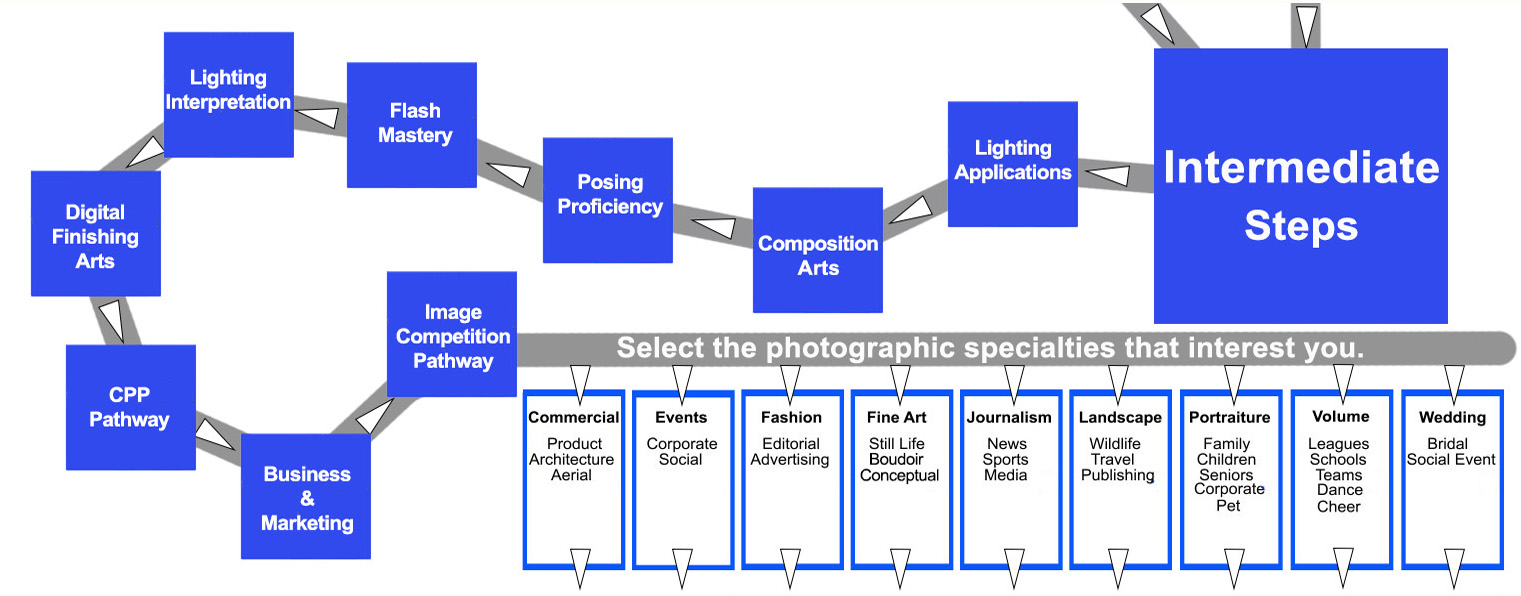Start Applying What You are Learning
The Intermediate Steps will take you on a deeper dive into each subject. You will now need to begin taking some of TPPA’s live classes and workshops. Attending Texas School is a great way to get a ton of education in a single week.
As you begin to collect the Intermediate Success Badges, you may be ready to start booking clients as you continue to improve your skills and pursue your craft.
Click on any step to learn more!

Lighting Applications
Lighting Applications – Includes an understanding of various light sources (constant light, speed light, studio strobes, natural light) and the appropriate use of each type of light source to achieve a desired effect. Also includes the mechanics of using modifiers to alter the light source to create desired patterns and qualities.
Lighting Interpretation
Lighting Interpretation – This includes the application of all lighting types and modifiers to create a visual statement in keeping with the subject matter, mood and visual strength of an image. This includes the ability to create lighting patterns (broad, short, Rembrandt) that flatter the subject as well as control of lighting ratios and lighting for detail and texture. Also includes a full understanding of low key and high key lighting and how to achieve it.
CPP Pathway
CPP Pathway – This includes a continuation of study for the exam and declaring your CPP candidacy and sitting for the exam. Also included is the understanding and preparation for Image Submission. This would also include the creation of the compulsory images as well as an evaluation of your own client images for submission.
Posing Proficiency
Posing Proficiency – Includes the creation of a posing repertoire for individuals, couples, families and group. Also includes creating masculine and feminine poses as well as corrective posing techniques.
Composition Arts
Composition Arts – This includes the skills to create strong compositions through subject placement, foreground and background interests, color balance, and more.
Image Competition Pathway
Image Competition – This includes the early stages of preparing and entering images in competition. At this level, participants seek a deeper understanding of creating and editing images and their final presentation for success in competition. Also includes understanding judge's feedback and how to apply image critiques to create even stronger images.
Flash Mastery
Flash Mastery – This badge includes skills needed to completely control the output and quality of a portable flash. Includes complete operation in manual mode, all aspects of off-camera flash, use of multiple strobes and why, and the benefits and shortfalls of various remote trigger types.
Digital Finishing Arts
Digital Finishing Arts – These skill sets include the ability to retouch images with a high degree of proficiency including use of layers and brush adjustments, as well as background enhancements, background extractions, head swaps, removal of unwanted elements, sky replacements or enhancements, tonal and color adjustments, added textures and image softening.
Business and Marketing
Business and Marketing – Developing a Marketing Plan, Pricing for Profit, Developing a Growth Strategy, Community Involvement, Partnerships, Alliances and other ‘Business Builders’, expanded product lines.
Intermediate Steps
At the intermediate level, you start applying the fundamentals you learned during the First Steps and actively putting those skills to use while refining your technique across a broad spectrum and for specific disciplines. Growth at this level is prolific. Typically, we anticipate a rapid improvement in the quality of your images and a surge in the creativity of your images if you are really applying yourself.
Commercial Photography
“In every area or type of photography you choose, there are numerous skills you need to learn and possess to be able to create the best possible images. Commercial photography refers to creating images to sell products and/or services, architecture and aerials. You see commercial photography every time you open a catalog or see an advertisement on a billboard or the internet. To be a good commercial photographer requires a number of skills, many of which overlap with other areas of photography.
Lighting and composition are two of the things that first come to mind. Learn as much as you can about both. Basic art courses are a wonderful source of inspiration and learning. Light control is one of the most difficult principles to learn. Taking the light off the camera and controlling one to a number of lights can give you control over your subject you could not achieve otherwise. This is the key to light interpretation and mastery.
The camera is merely a tool you used to capture an image. Camera controls are a must to be able to excel in your field. Learn everything you can about each camera and lens and which combination to use. Concentrate on what you trying to achieve without having to stop and worry about your camera functions. Learn and understand the principles of the 18 per cent grey card and when to rely on a grey card and when to use an incident meter.
As with any area of photography, it requires constant learning. One of the best resources we have is the Texas School. Take a class every year if possible. Study and get your certification degree. Print competition is a must to help you learn as you progress in your knowledge.”
– Robert Suddarth, Commercial Photographer and TPPA Member
Photojournalism including News, Sports and Media photography
“Having a background in photojournalism is an added strength in the world of today’s photography practices. Skills such as having the ability to adjust to various situations, as well as being able to do so quickly and efficiently while looking at the situation from multiple angles definitely ads further strength and perspective. Being aware of various lighting options, such as available light, flash and reflective lights adds to one’s capability as well. In addition, quickly knowing the best lens to use in different situations also assists in capturing the situation in a quick, effective manner.”
– Hardy Meredith, Photojournalist/Media Photographer and TPPA Member
Notice the doors above. These represent possible disciplines you may be considering as a photographer. Of course, there are even more possibilities than we have shown here, but this graphic does illustrate several key areas of interest.
Each of these disciplines comes with the need for a unique skill set to be successful. Furthermore, each of these also has a totally unique experience for the photographer and the consumer of the final images. Finally, each also requires a unique business model and marketing strategy if one wants to derive at least some portion of their income from their photography.
It is certainly possible that a photographer might desire to be involved in several of these disciplines. That could make great sense in that some of these disciplines support each other photographically and professionally. With that being said, you might come to realize that for every door you wish to open, there is that much more you need to learn in order to be successful in multiple endeavors.
